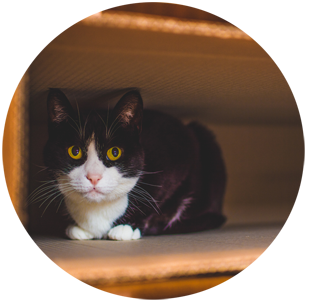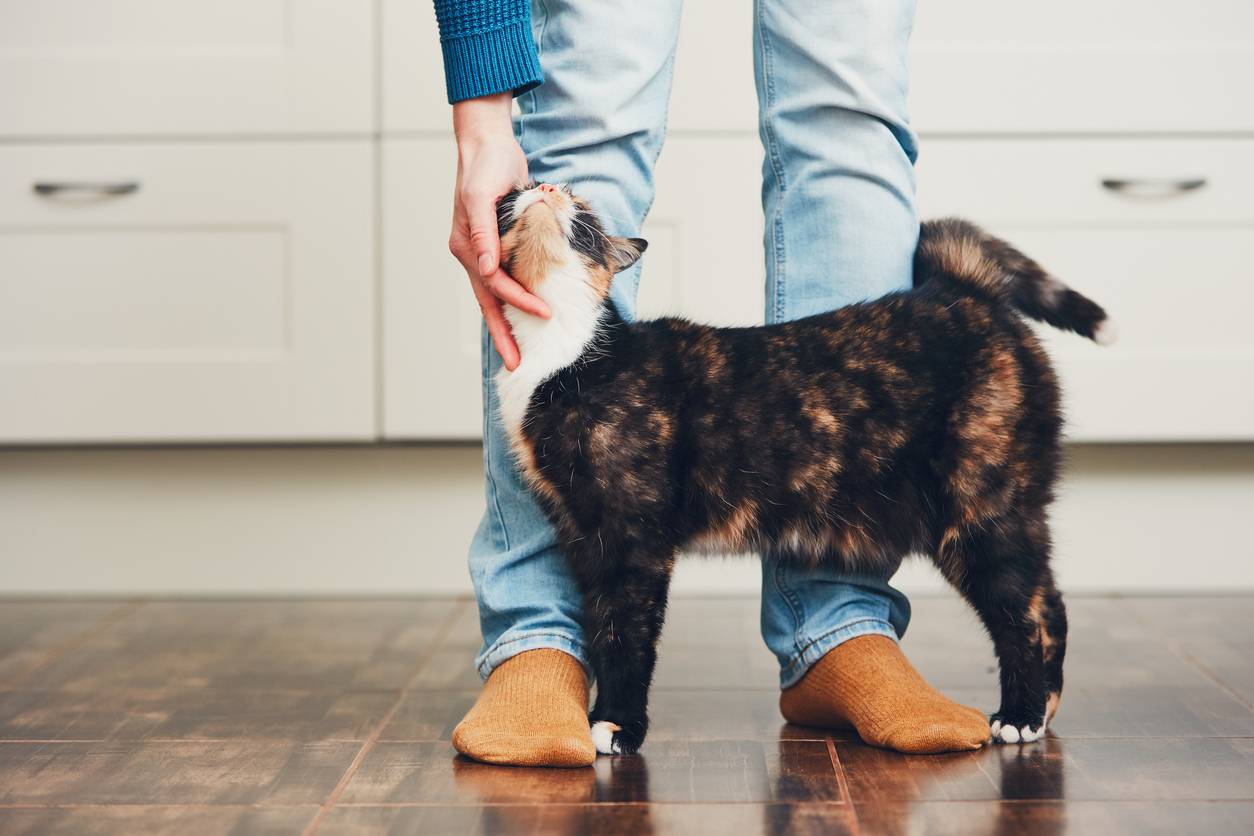
Tip #1: Monitor Cat Health While Cleaning the Litter Box
“Scooping out the litter box isn’t just about keeping it clean,” Johnson-Bennett says. “It’s also an important tool in monitoring your cat’s health. Every time you scoop, pay attention to the appearance of your cat’s waste. Changes in appearance, size or odor may indicate a potential health issue.”
Litter box scooping only takes a few moments and monitoring your cat’s output may provide an early warning that veterinary attention is needed. An alert cat parent’s observation of a change in litter box contents is often the first indication of diabetes, cystitis, kidney issues, or bowel problems.
Tip #2: Be Choosy About Your Litter Box
Is your cat’s litter box the right size? “When choosing a litter box, match it to the size of your cat,” Johnson-Bennett advises. “Don’t be tempted to get a small box just so it will conveniently fit in a tucked-away corner of a room. Ideally, the litter box should be 1 ½ times the length of your cat from the tip of the nose to the base of the tail.”
If you can’t find a large enough box, consider using a plastic storage container. You can find these at your local home improvement or discount store. Your cat will appreciate not having to use cramped accommodations when nature calls.
Whether you’re a first-time cat owner or a veteran kitty parent, learn more about How to Set Up a Litter Box for success.
Tip #3: Play with Your Cat to Increase Happiness & Bonding
Playing with your cat isn’t just fun, it’s healthy. Johnson-Bennett says, “Playtime may seem as if it’s something cats will naturally do on their own, but it’s important for YOU to participate in the sessions for it to be a truly beneficial behavior tool.”
Pam’s advice: “Engage in at least two interactive play sessions each day with your cat. Use a toy based on a fishing pole design so you can control the movements. Move the toy like prey to trigger a natural response from your cat.”
Playtime helps not only with physical health, but with mental/emotional health as well. It’s a great way to increase a timid cat’s confidence, ease stress and build trust between the two of you. Interactive playtime is a valuable addition to other training and behavior work you’re doing with your cat.
Here’s another important reminder: make sure your cat gets to have several successful captures during the game and then one final grand capture at the end. Make playtime fun and rewarding for kitty – and for you!
Tip #4: Is it Time for a New Litter Box?
Your cat’s litter box isn’t designed to last forever. Litter boxes get scratched and kitty claws can leave tiny lacerations in the plastic for bacteria to hide. Scratched and worn litter boxes can end up creating an unpleasant odor, even with fresh litter. “Every time you wash the litter box, check to make sure it’s still in good shape,” Johnson-Bennett advises. If you notice litter sticking to specific areas, a lot of scratches in the surface, or a change in the color or texture of the plastic, it’s probably time for a new litter box.
Pam’s recommendation: “Replace your cat’s litter box every one-two years, depending on condition.”
See Tip #2 to make sure you choose a new litter box that’s sized for your cat(s).
Tip #5: More than One Litter Box May Help Cat Training and Behavior
According to Johnson-Bennett, “some cats develop a preference when it comes to only urinating in one litter box and defecating in another. If only one box is available, the cat may decide to urinate in there but leave solid waste in another area of the room.”
Always have your cat examined by the veterinarian to rule out medical causes for the behavior, but in some cases, adding an additional box for kitty’s particular elimination habits helps.
Johnson-Bennett’s advice: “When setting up the additional box, don’t place it right next to the original box. If your cat has chosen the same area outside the litter box to use repeatedly, place the additional box there. If not, place the new box in the same room as the original litter box but make sure there’s distance between them.”
Learn more tips for and additional tips for getting kitty to use the litter box what to do if you’re having trouble with your cat peeing or pooping outside of the litter box.

Tip #6: Help a New or Fearful Cat Adjust with Adequate Hiding Spots
If there’s one meme that even non-cat owners know about feline friends, it’s “if it fits, I sits.” Cats love to climb in boxes and bags and will even lay down on top of carpet squares or a taped-off section of the floor. But if you’re bringing a new kitty into your home or helping a timid one adjust, having places to hide is even more important.
“Hiding is a valuable coping mechanism and can allow a fearful cat to feel more in control in a new or unsure environment,” Johnson-Bennett says. “Hiding gives the cat the chance to calm down and interact at a comfortable pace.”
“To help timid or fearful cats feel more comfortable, make sure you have provided adequate hiding options in each room where your cat spends time,” she says.
Hiding places can include:
- semi-covered pet beds (A-frame or donut style)
- cardboard boxes
- open paper bags on their sides (all handles removed to prevent strangulation)
- DIY cat furniture with high places or partially covered spots.
According to Johnson-Bennett, “When cats feel they have more hiding options, they may venture out from under the bed or from the back of a closet.” That gives you more time to play and interact with your furbaby and help kitty feel safe and loved.
Tip #7: Control Your Urge to Rub a Cat’s Belly
Newsflash: “When cats roll over onto their backs and expose their bellies, it doesn’t mean they’re asking for a tummy rub,” Johnson-Bennett says. “This is a behavior cat parents misunderstand because they connect how often dogs display this behavior to request a good belly scratch.” Remember: cats are cats, dogs are dogs, humans are humans, and their body language doesn’t mean the same thing.
According to Johnson-Bennett, the behavior of rolling over on the back and exposing their belly indicates very different feelings for a cat, depending on the immediate circumstances. For example, in a tense cat-to-cat stand-off, one kitty may roll onto his back to indicate that he’d prefer not to fight but if the opponent continues forward, all weapons (claws and teeth) will become engaged. In a relaxed setting, a cat may stretch out onto his back and expose his belly because he feels completely at ease and safe.
If you make the mistake of assuming this posture is an invitation to pet that soft belly, you will likely elicit an automatic defensive response from your cat. This could result in your hand getting scratched or bitten. Although there are some cats who tolerate – or may even enjoy – having their tummies touched, most don’t, so use caution.
Read some more advice and cat behavior tips from Pam Johnson-Bennett and learn how to understand your cat’s language or know if kitty is happy.



